Weeds
Weeds That Grow in Lawns
There are two kinds of weeds that grow in lawns; weeds that look like grasses, and weeds that look like salad. Here’s how to recognize and deal with weeds in your lawn.
Weeds That Look Like Grasses:

Poa Annua (Annual Bluegrass)
Poa Annua is an annual grass that starts in fall from seed, grows through the winter, then dies in the summer. It mimics lawn grasses because it looks similar to desirable grasses. It causes brown areas when it dies off in early summer (as soon as it gets warm). It makes seeds just before it dies; the seeds wait all summer and start new plants again in late fall. It can be identified in winter by examining the blades; some blades will have wrinkles running across the blade. The wrinkles are caused by a nematode parasite that only affects poa annua.
Control: Use a pre-emergent seed killer around Halloween and again in early January for several years in a row. The seeds will sprout but will be killed by the pre-emergent. Pre-emergent is like birth control because timing is everything. Using a pre-emergent in summer to control poa annua is a waste because no poa annua seeds are sprouting; they wait untill fall and so should you. A good pre-emergent is “Halts” by Scotts. It is available alone or in a fertilizer mix and is listed to control poa annua. There are other pre-emergents available; look online for options.
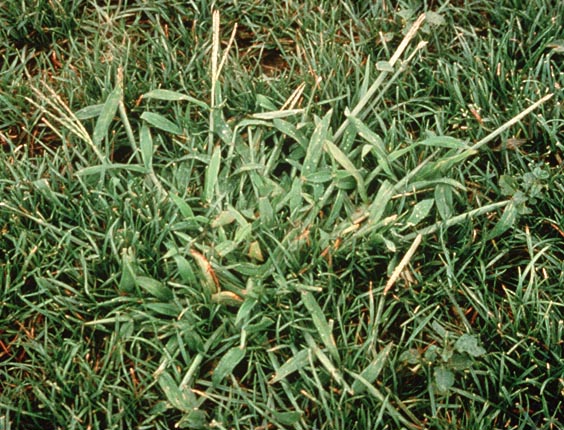
Crabgrass
Crabgrass is an annual grass that starts in spring from seed, grows through the summer, then dies in the fall. Seeds are produced within two weeks from sprouting and continue all summer long. Plants are easy to pick if there are just a few. To pick crabgrass, run your finger around the base of each plant to isolate it from the desired lawn grasses, then grab the center (plus a pinch of dirt) and pull back and forth and right and left while pulling up. The roots are very shallow and pull up easily.
Control: Keep the lawn mown tall to prevent seeds from starting. Do not water daily because seeds need daily watering to become established. Pick or spray existing plants with Ortho Crabgrass Killer or Bayer Advanced All-in-One Lawn Weed Killer. These chemicals will not damage the lawn grasses when used properly. Use a pre-emergent seed killer around mid-March and again in early July. The seeds will sprout but will be killed by the pre-emergent. Pre-emergent is like birth control because timing is everything. Using a pre-emergent in winter is a waste because crabgrass seeds are not sprouting; they wait until spring and so should you. A good pre-emergent is “Halts” by Scotts. It is available alone or in a fertilizer mix and is listed to control crabgrass.

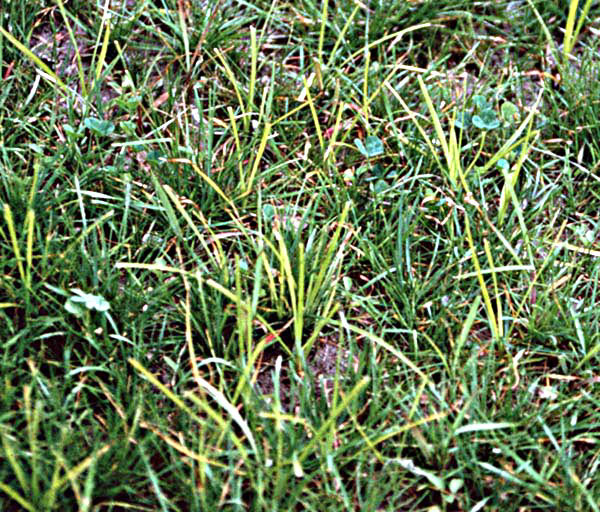
Nut sedge / Nut grass
Top: Uprooted Bottom: Growing in a lawn
This is really a sedge, not a grass. When cut, the stem has three sides. Pulling it up will do no good at all because there are small nut-like roots that break off and stay in the soil. The nuts can lie dormant for years and then sprout. It is usually brought in by re- sodding and is unnoticed when closely mowed.
Control: Although seeds will spread this plant, they rarely form in lawns because they get mowed off. The only way to control nut sedge is with a spray such as Ortho Crabgrass Killer or Bayer Advanced All-in-One Lawn Weed Killer. Both products seem to work, but repeated applications are necessary to kill new sprouts produced by the previously dormant nuts in the soil.
Sedges are ancient plants and are difficult to kill. Be aware that proper mowing and watering are required to prevent the lawn grasses from becoming stressed out during treatment.

Bent Grass
Some people get bentgrass in their lawns and it looks like the image to the left. If the lawn is 100% bentgrass, there’s no problem, but when it invades a fescue or bluegrass lawn, it contrasts badly due to its fine texture and a different shade of green. Bentgrass is the grass used on putting greens, and is much more difficult to grow because it creates thatch and is susceptible to insects and fungus.
Bentgrass seeds are tiny and usually arrive with the wind or in bird droppings. Seeds will form but not unless it is allowed to grow very tall (over 1 foot). It is a perennial grass.
Control: Very difficult to eradicate, digging it out won’t work, no selective weed killer is known. However, some suppression and control can be had using Turflon weed killer. Turflon has a damaging effect on bentgrass but requires repeated applications.

Foxtails
Foxtails are a summer annual grass that can be very annoying. It starts in spring, grows all summer, then dies in the fall. There are several species of foxtails that grow in lawns, but they are all annuals.
Control: Foxtails can be controlled two ways: spraying existing plants or preventing seeds using pre-emergent. Use Ortho Crabgrass Killer to kill existing plants, or use Scotts Halts pre-emergent in the spring to kill the seeds before they emerge.
Keep the lawn mown tall to prevent seeds from starting. Do not water daily because seeds need daily watering to become established.
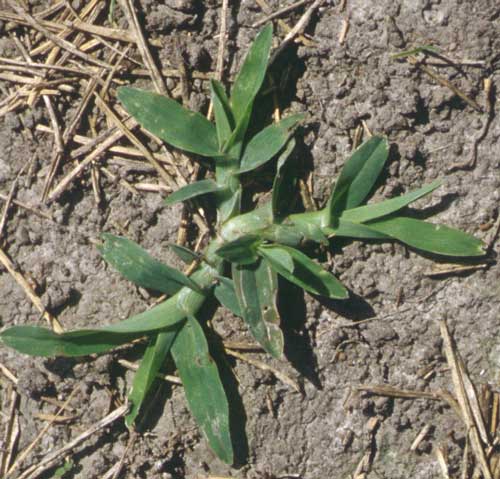
Goose grass
Goose grass is a summer annual grass that can also be very annoying. It starts in spring, grows all summer, then dies in the fall.
Control: Goose grass can be controlled two ways: spraying existing plants or preventing seeds using pre-emergent. Use Ortho Crabgrass Killer to kill existing plants or use Scotts Halts pre-emergent in the spring to kill the seeds before they emerge.
Keep the lawn mown tall to prevent seeds from starting. Do not water daily because seeds need daily watering to become established.
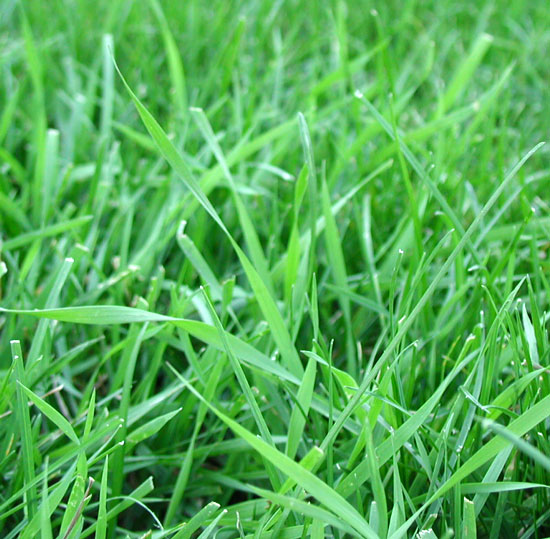
Quack grass
Quack grass is a perennial and is difficult to control since they resemble turf grasses in their tolerance to herbicides. They tolerate close mowing, and can persist indefinitely. Even though they stay green all year long, they have different color and growth rates, so they are objectionable as turf grasses. This grass spreads by underground creeping stems.
Control: there is no effective chemical control of quack grass short of killing the infected area, sterilizing the soil, and starting over.
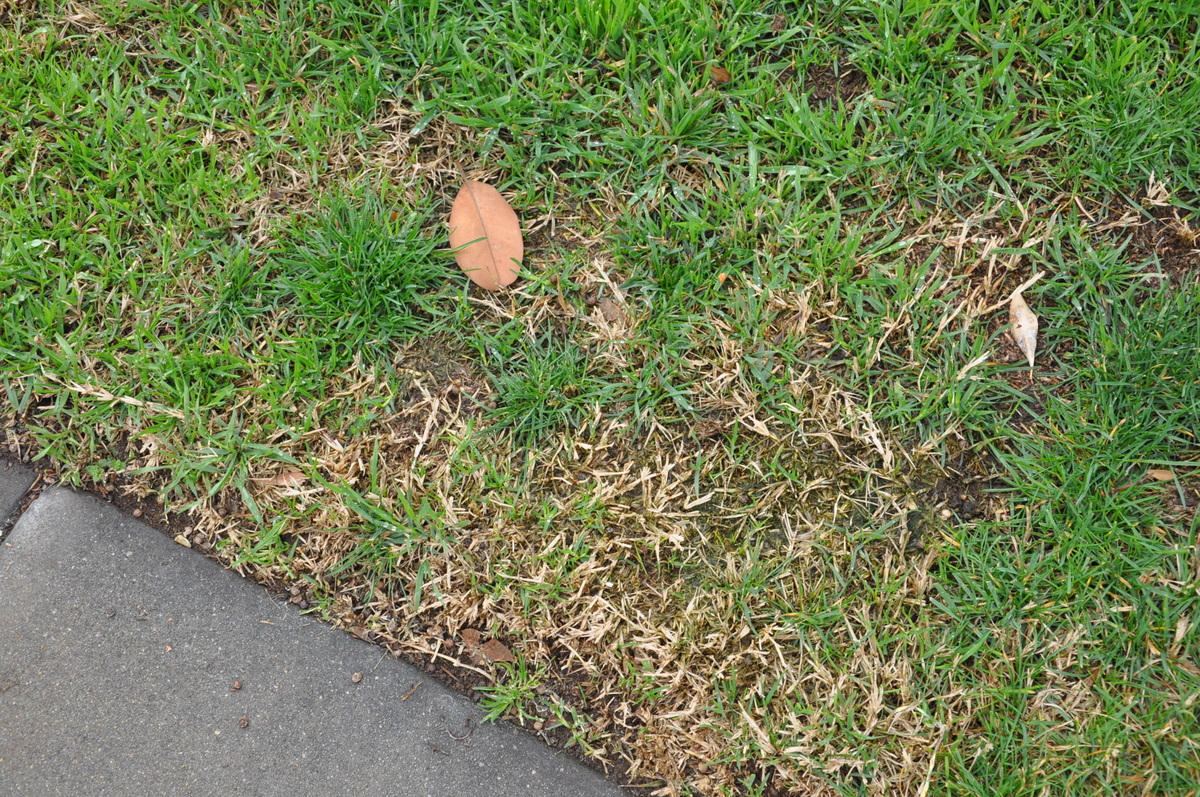
Bermuda grass
Bermuda grass is not technically considered a weed, but many of us don’t like it and try to get rid of it. Some call it Devil’s grass and other derogatory names. Bermuda is a subtropical grass that always goes “dormant” in the winter. Since it came from tropical climates, it does not tolerate the colder winters in the Bay Area. Seen here is an area of dormant Bermuda.
If your lawn is mostly Bermuda and has little to no green grass in winter, you can scalp and overseed in late fall to establish fescue that stays green all year long, provided you don’t encourage the Bermuda to resume activity by cutting your lawn too short in spring and summer.
If your lawn has Bermuda creeping in, you can control it and beat it back to submission, provided there are no large areas of strictly Bermuda. If it’s mixed into your fescue or bluegrass lawn, try using Turflon D broadleaf weed killer. You’ll likely need to get it online or possibly at your local Ewing Irrigation store. Don’t use Turflon D if your lawn is bentgrass, unless you want to kill the bentgrass. This stuff only works when the target grass is active, so don’t use it on dormant Bermuda!
Weeds That Look Like Salad:
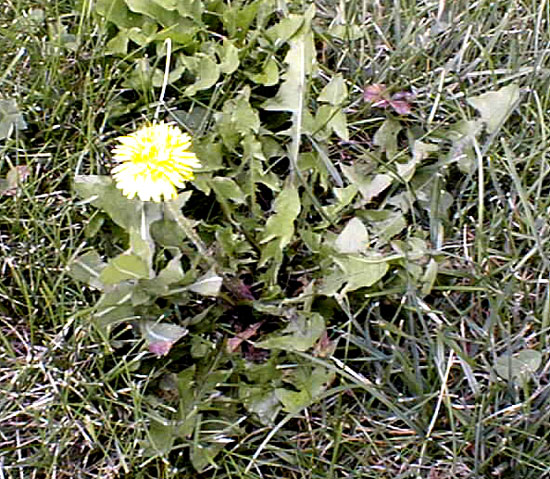
Dandelion
Would you eat this weed? Many people do (dandelion greens) but they really don’t belong in a lawn! Dandelions are biennial plants that persist in turf for years. They are by far the easiest to control because they are susceptible to all broadleaf weed killers. A newer variation has a flower with a very short stem in order to avoid being mowed off.
Control: Dandelions are easily killed using Ortho Weed-B-Gon or Bayer Advanced All-in-One Lawn Weed Killer. These chemicals will not damage the lawn grasses when used properly.
Pulling dandelions out is a risky choice because the tap root may break off, growing as large as a carrot before sending up new growth. As with all broad leaf weeds, spray in between mowing and do not water for several days.

White Clover
Clovers are broad-leaved weeds that are of the legume family. They produce their own nitrogen and are usually very green. Clover is a perennial plant that will grow anywhere but loves lawns due to the regular watering. Clover spreads in the lawn, producing burrs that contain seeds that can spread rapidly.
Control: Clovers are easily killed using Ortho Weed-B-Gon or Bayer Advanced All-in-One Lawn Weed Killer. These chemicals will not damage the lawn grasses when used properly.
Pulling clover out will not succeed because of the stems growing underground. As with all broad-leaved weeds, spray in between mowing and do not water for several days.
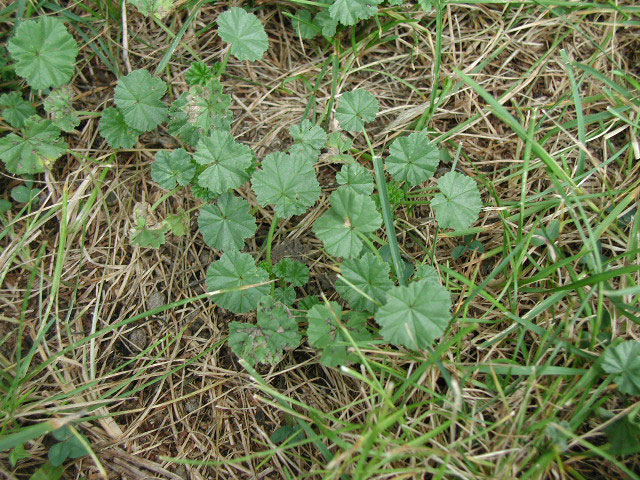
Mallow (pennywort)
Mallow is a perennial plant that resembles ground ivy. It spreads from a central root and can be successfully pulled out if there are not too many plants. Usually, there are stands that resemble dichondra. The leaf edges look serrated.
Control: Mallow ivy is killed using Ortho Weed-B-Gon or Bayer Advanced All-in-One Lawn Weed Killer. These chemicals will not damage the lawn grasses when used properly.
As with all broad-leaved weeds, spray in between mowing and do not water for several days. You may need several applications for full control.
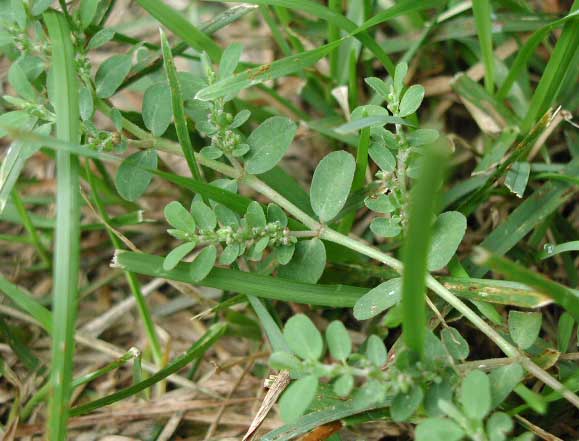
Spurge
Spurge is a perennial plant that leaks a milky fluid when broken. There are several types of spurge including spotted spurge, which has a redder stem and a purple spot on each leaf. Spurge creates seeds below the mower’s blades so getting control is important.
Control: Spurge is easily killed using Ortho Weed-B-Gon or Bayer Advanced All-in-One Lawn Weed Killer. These chemicals will not damage the lawn grasses when used properly.
As with all broad-leaved weeds, spray in between mowing and do not water for several days.
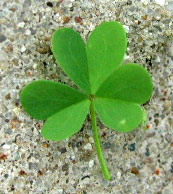
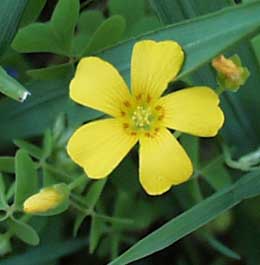
Oxalis
Don’t confuse this weed with clover – it’s MUCH smaller and has tiny yellow flowers. A relative of woodsorrel, oxalis is a woody herbaceous plant – unlike clover, which is a legume. Oxalis has a nasty habit: it has exploding seed heads! As each tiny yellow flower dies and dries up, a seed bud forms, and a powerful spring mechanism grows inside the bud. When the trap is sprung (usually by a passing lawn mower or a gust of wind), multiple seeds are thrown out up to 18″ away from the plant. The seeds germinate, and make new oxalis plants.
Control: Oxalis is easily killed using Ortho Weed-B-Gon or Bayer Advanced All-in-One Lawn Weed Killer, but you will need to spray several times to get the newly sprouted plants, as the seeds are unaffected by the weed killer. These chemicals will not damage the lawn grasses when used properly. As with all broad-leaved weeds, spray in between mowing and do not water for several days.

Black Medic
This weed looks like clover but it isn’t related. It was used as a medicinal treatment in ancient times and was the base for tonics and potions. Its leaves are smaller than clover and bigger than oxalis. It sometimes has a purple or darker color and usually grows in the shade.
Control: Black medic is easily killed using Ortho Weed-B-Gon or Bayer Advanced All-in-One Lawn Weed Killer, but you will need to spray several times to get the newly sprouted plants, as the seeds are unaffected by the weed killer. These chemicals will not damage the lawn grasses when used properly.
As with all broad-leaved weeds, spray in between mowing and do not water for several days.

Ground Ivy
Ground ivy looks like giant mallow except that it has lobed leaves instead of serrated leaves. It has stubborn runners that are not easy to pull out. There are several types, but all are controllable when growing in turf.
Control: Ground ivy is killed using Ortho Weed-B-Gon or Bayer Advanced All-in-One Lawn Weed Killer, but you will need to spray several times to get complete control.
These chemicals will not damage the lawn grasses when used properly. As with all broad-leaved weeds, spray in between mowing and do not water for several days.
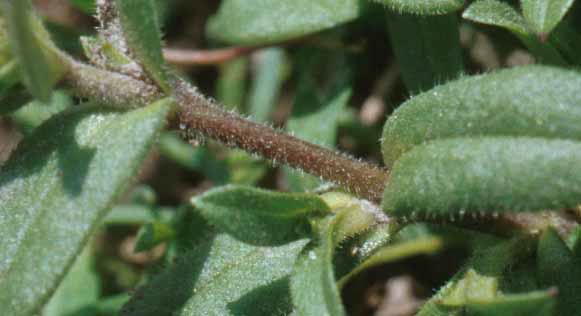
Mouse Ear Chickweed
This weed has several variations, “mouse ear” and “common.” They are similar to all broad-leaved weeds in that they are controlled using broad-leaf weed killer.
Control: Chickweed is easily killed using Ortho Weed-B-Gon or Bayer Advanced All-in-One Lawn Weed Killer, but you will need to spray several times to get the newly sprouted plants, as the seeds are unaffected by the weed killer. These chemicals will not damage the lawn grasses when used properly.
As with all broad-leaved weeds, spray in between mowing and do not water for several days.

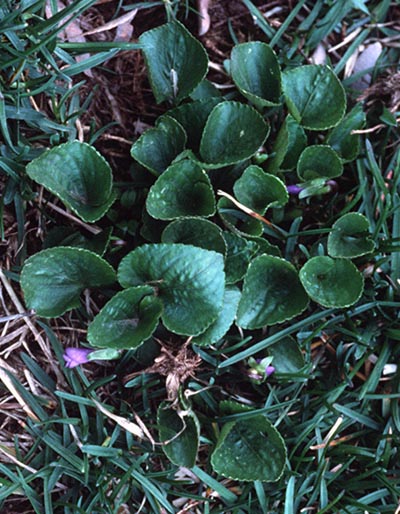
Wild Violets
These plants are the worst to try to pull because even the smallest root will propagate and make new plants. The good news is that they respond to the same weed killers as other broad leaved weeds.
Control: Violets are easily killed using Ortho Weed-B-Gon or Bayer Advanced All-in-One Lawn Weed Killer, but you will need to spray several times to get the newly sprouted plants, as the underground stems are unaffected by the weed killer. These chemicals will not damage the lawn grasses when used properly.
As with all broad-leaved weeds, spray in between mowing and do not water for several days.

Red Sorrel
Red sorrel is a persistent perennial weed that should be eradicated promptly because it spreads throughout the lawn area quickly. The controls that are most effective are made to young plants and plants that are growing new leaves.
Control: Sorrel is controlled using Ortho Weed-B-Gon or Bayer Advanced All-in-One Lawn Weed Killer, but you will need to spray several times to get the newly sprouted plants, as the seeds are unaffected by the weed killer. These chemicals will not damage the lawn grasses when used properly.
As with all broad-leaved weeds, spray in between mowing and do not water for several days.
Please use caution when spraying your weeds. Weed killer is a poison, but if handled properly can be completely safe. If you have pets, do not allow them to come into contact with treated areas until the lawn is completely dry. If you have cats, be sure that the cats do not eat grass that has been sprayed.
Does aerating help control or spread weeds? Click HERE to find out!
Questions about your lawns? Request a Free Quote!
Call Fairway at 1-800-497-4075 or Contact Us for free advice.Attach an image of your issue and we will be happy to help!We'll give you free expert advice about your lawns, whether you're a customer or not.
Call Fairway Lawn Service to have your lawns aerated, have Moisture Manager appliedto your lawn or yard or request a FREE QUOTE.
